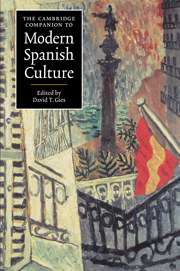Book contents
- Frontmatter
- Modern Spanish culture
- I Culture
- II Culture and history
- III Culture and prose
- IV Culture and poetry
- V Culture and theater
- VI Culture and the arts
- 17 Painting and sculpture in modern Spain
- 18 Culture and cinema to 1975
- 19 Culture and cinema, 1975-1996
- 20 A century of Spanish architecture
- 21 Spanish music and cultural identity
- 22 To live is to dance
- VII Media
- Index
- Series List
17 - Painting and sculpture in modern Spain
from VI - Culture and the arts
Published online by Cambridge University Press: 28 May 2006
- Frontmatter
- Modern Spanish culture
- I Culture
- II Culture and history
- III Culture and prose
- IV Culture and poetry
- V Culture and theater
- VI Culture and the arts
- 17 Painting and sculpture in modern Spain
- 18 Culture and cinema to 1975
- 19 Culture and cinema, 1975-1996
- 20 A century of Spanish architecture
- 21 Spanish music and cultural identity
- 22 To live is to dance
- VII Media
- Index
- Series List
Summary
Contemporary Spanish art is generally portrayed in histories as an uneven agglomeration of outstanding moments, boasting isolated figures of genius, and separated by periods of apathy. In contrast to the medieval era or the Golden Age, more recent art is largely disparaged. An exception is made, of course, for the works of a few major figures, though these products are often seen as heroic deeds of epic grandeur, conceived in a country that has otherwise failed to live up to its own glorious past tradition.
This is a conception that is both superficial and historiographically outmoded. Once a fuller understanding of the period in question is attained, a rich continuity of trends makes itself known, revealing numerous artists who not only represented their era masterfully but who also became figures of international standing in their own right. A history of European art would be incomplete if it claimed to value more than simple novelty or vanguardist movements, yet failed to take these artists into account.
Certainly by the nineteenth and twentieth centuries, Spain was no longer the world power of a bygone era. She was instead a nation struggling to modernize, burdened with a backward economy, a weak bourgeoisie, social and political instability, and periods of isolation - circumstances which could hardly be expected to inspire a flourishing of the arts.
- Type
- Chapter
- Information
- The Cambridge Companion to Modern Spanish Culture , pp. 239 - 247Publisher: Cambridge University PressPrint publication year: 1999



